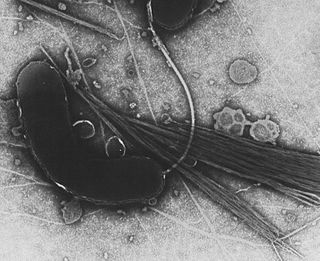
Gammaproteobacteria is a class of bacteria in the phylum Pseudomonadota. It contains about 250 genera, which makes it the most genera-rich taxon of the Prokaryotes. Several medically, ecologically, and scientifically important groups of bacteria belong to this class. It is composed by all Gram-negative microbes and is the most phylogenetically and physiologically diverse class of Proteobacteria.
Caldisericum exile is a species of bacteria sufficiently distinct from other bacteria to be placed in its own family, order, class and phylum. It is the first member of the thermophilic candidate phylum OP5 to be cultured and described.
Azonexus fungiphilus is a species of bacteria. It is a root bacteria and together with Azonexus caeni is one of the two species in the genus.
Desulfofrigus oceanense is a bacterium. It is a psychrophilic Gram-negative and sulfate-reducing bacteria with type strain Asv26T.
Desulfofrigus fragile is a bacterium. It is a psychrophilic Gram-negative and sulfate-reducing bacteria with type strain Lsv21T.
Glutamicibacter soli is a species of gram-positive bacteria.
Paeniglutamicibacter antarcticus is a species of bacteria. It is Gram-positive, motile, aerobic and has a rod–coccus cycle.
Psychroserpens burtonensis is a species of psychrophilic, yellow-pigmented bacteria. It is non-motile and nutritionally fastidious. Its type strain is ACAM 188.
Gelidibacter algens is a species of psychrophilic, yellow-pigmented bacteria. It is saccharolytic, exhibits rapid gliding motility, and its cells are rod-like to filamentous. Its type strain is ACAM 536.
Sulfurovum lithotrophicum is a species of bacteria, the type species of its genus. It is a sulfur-oxidizing chemolithoautotroph within the ε-Proteobacteria isolated from Okinawa Trough hydrothermal sediments. It is mesophilic and also oxidises thiosulfate. It is a Gram-negative, non-motile and coccoid to oval-shaped bacterium. The type strain is 42BKTT.
Halobacteroides halobius is a species of bacteria, the type species of its genus. It is a moderately halophilic, anaerobic, long rod-shaped, motile, Gram-negative and non-sporulating bacterium.
Anaerolinea thermophila is a species of filamentous thermophilic bacteria, the type and only species of its genus. It is Gram-negative, non-spore-forming, with type strain UNI-1T.
Caldilinea aerophila is a species of filamentous thermophilic bacteria, and the type species of its genus. It is Gram-negative, non-spore-forming, with type strain STL-6-O1T.
Desulfotomaculum arcticum is a spore-forming, moderately thermophilic, sulfate-reducing bacterium. Its type strain is 15T.
Levilinea saccharolytica is a mesophilic, non-spore-forming, non-motile, Gram-negative, filamentous bacteria with type strain KIBI-1T, the type species of its genus.
Leptolinea tardivitalis is a mesophilic, non-spore-forming, non-motile, Gram-negative, filamentous bacteria with type strain YMTK-2T, the type species of its genus.
Anaerolineaceae is a family of bacteria from the order of Anaerolineales. Anaerolineaceae bacteria occur in marine sediments. There are a total of twelve genera in this family, most of which only encompass one species. All known members of the family are Gram-negative and non-motile. They also do not form bacterial spores and are either mesophilic or thermophilic obligate anaerobes. It is also known that all species in this family are chemoheterotrophs.
Leptolinea is a bacteria genus from the family of Anaerolineaceae with one known species.
Levilinea is a bacteria genus from the family of Anaerolineaceae with one known species.
Cytophagales is an order of non-spore forming, rod-shaped, Gram-negative bacteria that move through a gliding or flexing motion. These chemoorganotrophs are important remineralizers of organic materials into micronutrients. They are widely dispersed in the environment, found in ecosystems including soil, freshwater, seawater and sea ice. Cytophagales is included in the Bacteroidota phylum.
